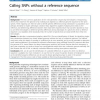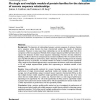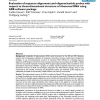2345 search results - page 95 / 469 » Comparing sequence scaffolds |
BMCBI
2010
13 years 7 months ago
2010
Background: The most common application for the next-generation sequencing technologies is resequencing, where short reads from the genome of an individual are aligned to a refere...
BMCBI
2010
13 years 7 months ago
2010
Background: While most multiple sequence alignment programs expect that all or most of their input is known to be homologous, and penalise insertions and deletions, this is not a ...
BMCBI
2010
13 years 7 months ago
2010
Background: High throughput sequencing has become an important technology for studying expression levels in many types of genomic, and particularly transcriptomic, data. One key w...
BMCBI
2006
2006
On single and multiple models of protein families for the detection of remote sequence relationships
13 years 7 months ago
Background: The detection of relationships between a protein sequence of unknown function and a sequence whose function has been characterised enables the transfer of functional a...
BMCBI
2006
13 years 7 months ago
2006
Background: Availability of high-resolution RNA crystal structures for the 30S and 50S ribosomal subunits and the subsequent validation of comparative secondary structure models h...



